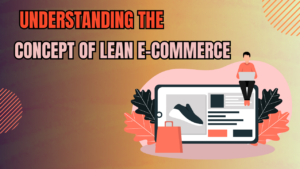Introduction to Lean E-Commerce
Do you ever get the sense that your online business feels a bit stagnant? bloated? You’re not alone. In the fast-paced world of e-commerce, it’s easy to get caught up in the whirlwind of features, products, and processes. But what if I told you there’s a way to trim the fat and boost your bottom line? Enter the world of lean e-commerce.
Understanding the Concept of Lean E-Commerce

Lean e-commerce isn’t about skimping on quality or cutting corners. It’s about working smarter, not harder. Think of it as giving your online store a good spring cleaning – getting rid of the clutter and focusing on what matters.
The Importance of Lean Principles in E-Commerce
In the ever-changing world of online commerce, the application of lean management principles is vital. These principles are focused on maximizing efficiency and minimizing the amount of waste while ensuring efficient processes. When implementing these strategies companies can increase efficiency, cut costs, and offer superior customer experience while remaining on top of the market in an ever-changing environment.
Implementing lean principles into online shopping can dramatically reduce costs while enhancing the general shopping experience. Through streamlining processes and removing inefficiencies, companies can increase productivity. This also lets you create more targeted marketing campaigns and ensures that funds are allocated in a way that will maximize impact and increase growth.
Step 1: Simplify
simplify is the key to adopting the lean eCommerce method. By reducing the complexity involved in the eCommerce business this process creates a flexible environment. This allows for more efficient product development and enables an efficient and responsive eCommerce strategy. Simplification is the foundation of efficiency in operations
Ready to declutter your digital shelves? Let’s dive into the first step of our lean e-commerce journey: simplification.
Identifying Complexity in Your E-Commerce Operations

Streamlining Product Listings and Descriptions
Simplifying the Checkout Process
Ever abandoned a cart because the checkout process felt like filing your taxes? Absolutely, your clients share the same sentiment. Streamline that checkout process until it’s smoother than a fresh jar of skippy.
Reducing Inventory Overload
Having too much inventory is like trying to stuff a week’s worth of clothes into a carry-on bag – it’s stressful and inefficient. Time to Marie Kondo your warehouse and keep only what sparks joy (and sales).
Improving Site Navigation and User Interaction
If your website is a maze, your customers are the confused mice. Make it easy for them to find the cheese (aka your products) with intuitive navigation and a user-friendly design.
Leveraging Automation Tools for Simplification
Automation is your new first-class pal. From order processing to email marketing, let the robots handle The repetitive stuff so that you can cognizance on developing your enterprise.
Case Study: Simplification Success Stories
Let’s take a peek at a few actual-international examples. Take “Gadget Galaxy,” an electronics e-tailer that was drowning in complexity. By simplifying their product range and automating their inventory management, they saw a 30% increase in sales and a 50% reduction in customer service inquiries. Talk about a stunning transformation!
Step 2: Save
Save focuses on refining a lean eCommerce brand by optimizing business operations. This involves analyzing customer behavior to identify inefficiencies and strategically eliminate waste. By conserving resources, businesses can reallocate funds to value-driven initiatives, enhancing overall profitability and customer satisfaction.
Reducing Expenses While Maintaining High Standards

Saving money doesn’t mean becoming a penny-pinching Scrooge. It’s about being smart together with your resources. Think of it as happening a monetary food regimen – reducing the junk, but still getting all the nutrients you need.
Efficient Inventory Management Strategies
Your inventory is like a garden – tend it carefully, and it’ll bloom. Neglect it, and you’ll end up with a costly, overgrown mess. Implement just-in-time inventory practices and watch your storage costs shrink.
Enhancing Efficiency in Supply Chain and Logistics Operations
A streamlined supply chain is like a nicely-oiled gadget. Identify bottlenecks, negotiate better deals with suppliers, and watch your efficiency soar. Remember, every penny saved in logistics is a penny earned in profit.
Reducing Waste and Redundancies
In the world of lean e-commerce, waste is the enemy. Whether it’s excess packaging or redundant processes, it’s time to wage war on waste. Your pockets (and the planet) will thank you.
Utilizing Data Analytics to Drive Savings
Data is the new oil, and it’s time to start drilling. Use analytics to understand your costs, predict trends, and make informed decisions. It’s similar to getting a crystal ball to guide your company.
Implementing Cost-Effective Marketing Strategies
Marketing doesn’t need to cost the equivalent of a pound and a cent. From social media to content marketing, there are plenty of ways to get bang for your buck. It’s not about outspending your competition – it’s about outsmarting them.
Real-World Examples of Cost Savings
Let’s look at “Frugal Fashions,” an online clothing store that embraced lean principles. By optimizing their supply chain and implementing data-driven marketing, they reduced their operating costs by 25% while increasing their customer base by 40%. Now that’s what I call dressing for success!
Step 3: Succeed
Succeed involves leveraging a lean eCommerce approach to optimize business strategy. By employing advanced management techniques, businesses can enhance efficiency and streamline operations. This method drives sustainable eCommerce growth, positioning the company for long-term success and a competitive edge in the digital marketplace.
Setting Clear and Achievable Goals

Success without a roadmap is like trying to navigate without GPS – you might get there eventually, but you’ll waste a lot of time and resources along the way. Set SMART goals (Specific, Measurable, Achievable, Relevant, Time-bound) and chart your course to e-commerce success.
Building a Customer-Centric Approach
In lean e-commerce, the customer isn’t just the king – they’re the whole royal family. Every decision, every change, every innovation should be viewed through the lens of customer satisfaction. Customers who are happy are repeat customers and returning customers are the lifeblood of your company.
Utilizing Lean Metrics for Success Measurement
You can’t improve what you don’t measure. But in the lean world, we’re not just measuring for the sake of it. Focus on metrics that matter – conversion rates, customer lifetime value, and net promoter score. These are the vital signs of your e-commerce business.
Enhancing Customer Service and Support
E-Commerce Retail Specialist Secrets emphasizes the importance of enhancing customer service. A lean eCommerce business utilizes its eCommerce platform to seamlessly integrate product development and marketing, ensuring a cohesive experience. This approach fosters customer loyalty and sets the stage for sustained success.
Continuous Improvement: Adapting and Evolving
The only constant in e-commerce is change. Embrace it. Foster a culture of continuous improvement. Today’s innovation is tomorrow’s old news, so keep pushing, keep evolving, and keep growing.
Leveraging Customer Feedback for Growth
Your customers are a goldmine of insights. Take note of them, learn from them and take action in response to their suggestions. It’s like having a free focus group at your fingertips.
Success Stories from Lean E-Commerce Businesses
Take “Lean Cuisine Emporium,” an online gourmet food store. By embracing lean principles, they not only streamlined their operations but also created a cult-like following among food enthusiasts. Their secret sauce? An unstoppable focus on feedback from customers and constant improvement. The result? A 200% increase in repeat customers and a 150% boost in annual revenue. Now that’s a recipe for success!
Integrating Lean E-Commerce Across Departments
Lean isn’t just for operations or marketing – it’s a philosophy that should permeate every aspect of your business.
Collaboration Between Teams for Lean Implementation
Break down those silos! Encourage cross-functional collaboration. When your tech team, marketing mavens, and customer service gurus are all singing from the same lean hymn sheet, magic happens.
Training and Development for Lean Practices
Invest in your team. Train them in lean principles. Empower them to identify waste and propose solutions. Remember, your employees are on the front lines – they often have the best insights into where improvements can be made.
Creating a Lean Culture Within Your Organization
Lean isn’t just a collection of methods – it’s also an attitude. Foster a culture where continuous improvement is the norm, where innovation is celebrated, and where efficiency is everyone’s responsibility.
Overcoming Challenges in Lean E-Commerce
The path to lean isn’t always smooth. If you have the right mindset and the right tools, you will be able to overcome any difficulty.
Common Pitfalls and How to Avoid Them
From over-optimization to neglecting customer needs, there are plenty of ways to stumble on your lean journey. Stay vigilant, stay focused, and remember – the goal is to enhance value, not just cut costs.
Dealing with Resistance to Change
Change can be scary, especially for long-time employees set in their ways. Communicate, demonstrate the benefits, and lead by example. Remember, you’re not just changing processes – you’re changing minds.
Ensuring Long-Term Sustainability of Lean Practices
Lean isn’t a one-time thing – it’s a way of life. Build systems to ensure your lean practices stick. Regular audits, ongoing training, and a commitment to continuous improvement will keep you on the lean and narrow.
Conclusion
Recap of Key Points
We’ve covered a lot of ground, from simplifying operations to saving costs and setting ourselves up for success. Remember, lean e-commerce is about working smarter, not harder.
The Path Forward: Embracing Lean E-Commerce
The e-commerce landscape is ever-changing, but the principles of lean remain constant. By embracing simplicity, efficiency, and customer-centricity, you’re setting yourself up for long-term success.
Final Thoughts and Encouragement for Implementation
Implementing lean e-commerce isn’t always easy, but it’s always worth it. Start small, stay consistent, and watch as your business transforms. Remember that every journey starts by taking a single step, therefore, take that first step today!
Additional Resources
Recommended Books and Articles on Lean E-Commerce
For those hungry for more knowledge, check out “Lean Analytics” by Alistair Croll and Benjamin Yoskovitz, or “The Lean Startup” by Eric Ries. These books will give you a deeper dive into lean principles and how to apply them to your e-commerce business.
Tools and Software to Aid Lean E-Commerce Practices
From inventory management systems like Cin7 to analytics tools like Google Analytics, a wealth of software supports your lean journey. Do your research and find the tools that best fit your needs.
Contact Information for Lean E-Commerce Consultants
Sometimes, you need a guiding hand. Consider reaching out to lean e-commerce consultants who can provide personalized advice and support. Remember, investing in expertise can often save you time and money in the long run.
FAQs
How long does it typically take to see results from implementing lean e-commerce practices?
While some benefits can be seen almost immediately, significant results usually materialize for 3-6 months. Keep in mind that learning is a process, not an endpoint.
Can lean e-commerce principles be applied to a small startup?
Absolutely! Startups are often in the best position to implement lean practices from the ground up, avoiding the need to undo existing inefficiencies.
What’s the biggest challenge in implementing lean e-commerce?
Often, the biggest hurdle is resistance to change. It’s crucial to communicate the benefits clearly and get buy-in from all levels of the organization.
How does lean e-commerce impact customer experience?
When done right, lean e-commerce significantly enhances customer experience by streamlining processes, reducing errors, and allowing businesses to focus more on customer needs.
Is lean e-commerce just about cutting costs?
While cost reduction is a benefit, lean e-commerce is primarily about maximizing value for the customer while minimizing waste. It’s about efficiency and effectiveness, not just cost-cutting.
